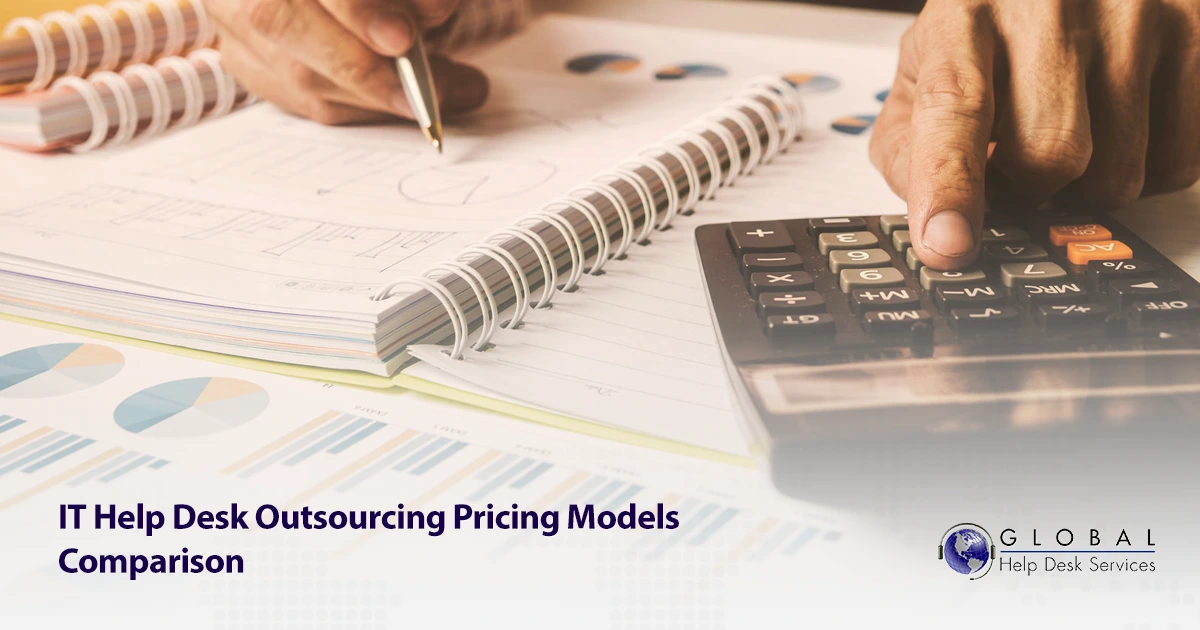How much does IT help desk outsourcing cost?
When it comes to outsourcing your IT help desk, you have a number of pricing models to choose from. But picking the best option isn’t as easy as it sounds.
Some vendors, for example, offer per-ticket, per-call, or per-minute, pricing. Other vendors offer a flat-rate pricing model. These per "unit" pricing models are attractive at first glance, as they seem to guarantee you will pay the lowest price for outsourced IT help desk services.
But before you choose a pricing model, you must first understand how each pricing model impacts your unique environment.
For example, does the model allow for overage charges? If it does, what happens to your costs when call volumes increase with a per-call pricing model (versus a flat-rate pricing model or a per-ticket model)?
Just Tell Me! What Does IT Help Desk Outsourcing Cost?
Want numbers? No problem.
With our free Help Desk Cost Calculator, you can quickly get the thousand-foot view of the cost of your help desk support.
To more accurately assess which IT help desk outsourcing pricing model works for you, it’s important to have certain metrics in hand:
- What are your average talk times?
- What is your average inbound-to-outbound ratio?
- How do these compare to industry averages or your own internal help desk costs?
These metrics affect how much you pay with some pricing models but may have zero impact on other pricing models. So, your answers to these questions will help you discover which pricing model is best for you … and the model that you eventually end up choosing might surprise you.
Related Reading: Measuring Your Real Help Desk ROI: 4 Steps to a Better Analysis
There are essentially five ways that outsourced IT help desk vendors may charge for their services. Here they are, described in detail, to help you make the right choice.
5 IT Help Desk Outsourcing Pricing Models
- Pay Per Ticket
- Pay Per Call
- Pay Per Minute
- Pay Per Agent
- Pay Per User
1. Pay Per Ticket
With this model, you pay for each incident (called a ticket) that your users generate by contacting the IT help desk. Essentially, if the vendor creates a ticket or works a ticket they didn't create, you pay. The vendor usually has a monthly minimum ticket volume commitment. The industry average cost per ticket for a call to Tier 1 support is $20.
Pro: The primary advantage of this pricing model is that you only pay for what you need, so if your IT help desk needs are light, so will your costs. You should not have to pay extra for status calls to the help desk on open tickets.
Con: Usually requires a monthly minimum ticket volume commitment. This model requires more hands-on management to monitor billing and review ticket resolution. And if users are pressured to only call if absolutely necessary, they may start turning to other, less secure sources to solve their IT issues.
2. Pay Per Call
Here, you pay for every call (also called “Pay Per Contact”) that the IT help desk handles on your behalf. This includes inbound calls (calls made from your company to the help desk), and outbound calls (calls that the help desk makes to your company, to follow up on open tickets, for example).
Pro: The one advantage of this pricing model is that it’s easy to understand. At first glance, and with a typically low cost-per-call rate, this model may seem less expensive than some of the other options.
Con: This model doesn’t encourage efficiency. Help desk agents, for example, might handle multiple calls to resolve issues that could have been resolved in one call. Because of this, costs can quickly add up. Imagine, for instance, a scenario in which your user places a call to the IT help desk to resolve an issue. That’s call number one, for which you pay. The agent asks the caller to restart their computer and call back. That’s call number two, another charge. Then the agent requires the caller to clear their cookies and cache, reboot, and call back again. If every ticket requires three to four calls, well … you get the idea.
3. Pay Per Minute
With this model, you essentially pay for talk time or work time, typically calculated per minute or per agent hour. This model operates like a taxi meter – the pricing keeps running even when the agent is making small talk, waiting for a screen to load, or is on mute (as opposed to putting the caller on hold, which stops the clock).
Pro: Again, this model may seem less expensive at first glance, as you’re only paying for the time you are using. If you already have a low average talk time, then it may be a good option.
Con: Paying per minute can quickly cause you to pay for the time that isn’t spent resolving support tickets. Agents, for example, who must follow a script that asks all callers how their day is going, or what the weather is like, are more costly than agents who skip the banter and get right down to business. Conversely, if the agents are encouraged to get calls done as quickly as possible, they may miss important information or inadvertently come across as curt and unpleasant to the caller.
4. Pay Per Agent
Here, you pay a flat rate per help desk agent. The agent might be dedicated to your organization, answering only your calls. Or the agent might be shared, answering calls from your organization as well as other organizations. This is a popular option and is usually used in conjunction with per-ticket pricing.
Pro: One of the advantages is your paid agents can eventually develop a good depth of knowledge about your systems, resulting in higher-quality support.
Con: A disadvantage is that this is typically the most expensive option, as you are paying for overhead costs and markup can be significant.
5. Pay Per User
With this model, you pay either for all IT users (Per-User Pricing), or you pay for all users who use a particular application (Per-Seat Pricing). Both variations are based on the anticipated number of tickets generated per month.
Pro: If you’ve been monitoring your call data over time and have a solid handle on your IT help desk needs, pay per user can offer an easy-to-manage solution: If your staffing changes, it’s easy to predict your IT help desk costs.
Con: If you haven’t been tracking your most pertinent KPIs, such as number of tickets generated per month, average first-call resolution rate, and average talk time, then we would advise determining those metrics first and then assessing if this model is right for your business. You don’t want to pay for support calls that your users never make. And you don’t want to pay a flat fee per user when paying by the ticket is more affordable.
How We Price Our IT Help Desk Services
At Global Help Desk Services, Inc., we typically charge per incident or per unique ticket. If a client calls with a problem, we generate a ticket and start working with them to resolve the issue. If they call us back two or three times through the lifecycle of the incident or ticket, we don’t charge a dime for the extra calls or the extra time.
The final price that our clients pay is based on their monthly incident volume, hours of coverage, and the type of service provided. Our focus isn’t on increasing the number of tickets, the number of calls, or the number of minutes we spend on the phone. Our focus is on helping our clients solve their issues.
If you have read this far, you are likely wondering about dollars and cents. How much does outsourcing your help desk cost, exactly (or even inexactly)? Find out first what your costs are so you have something to compare to by using our handy Help Desk Cost Calculator. Next you can take the average cost per ticket referenced in #1 Pay Per Ticket to compare your costs to the industry. Finally, if you’d prefer to talk to a human about what your cost would be to outsource to Global Help Desk Services, we are at your service, let’s talk.

